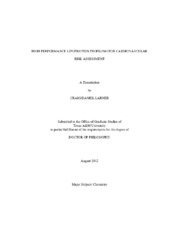| dc.contributor.advisor | Macfarlane, Ronald D. | |
| dc.creator | Larner, Craig | |
| dc.date.accessioned | 2012-10-19T15:30:12Z | |
| dc.date.accessioned | 2012-10-22T18:00:19Z | |
| dc.date.available | 2014-11-03T19:49:13Z | |
| dc.date.created | 2012-08 | |
| dc.date.issued | 2012-10-19 | |
| dc.date.submitted | August 2012 | |
| dc.identifier.uri | https://hdl.handle.net/1969.1/ETD-TAMU-2012-08-11566 | |
| dc.description.abstract | With the severity of cardiovascular disease (CVD) and the related mortality rate to this disease, new methods are necessary for risk assessment and treatment prior to the onset of the disease. The current paradigm in CVD risk assessment has shifted towards the multivariate approach over the individual use of traditional risk factors or lipid measurements. Through a combination of analytical techniques and multivariate statistical analysis, a novel method of cardiovascular risk assessment was developed. The analytical techniques employed include density gradient ultracentrifugation (DGU) and matrix assisted laser desorption ionization mass spectrometry (MALDI-MS) applied to human serum. These techniques provided detailed information about the characterization of the lipoproteins and their structural components, specifically the apolipoproteins belonging to high density lipoproteins (HDL). This information when combined with multivariate statistical analysis provided a method that accurately identified the presence of CVD in clinical studies between cohorts of subjects that had been previously diagnosed with CVD and cohorts of subjects that had been identified as healthy controls (CTRL) based on a clear angiography.
The lipoprotein density profiles were divided into subclasses based on their density and measured using a fluorescent probe to tag the lipoprotein particles. Use of multiple ethylenediaminetetraacetic acid (EDTA) based solutes allowed for the manipulation of the density gradient formation in order to separate the lipoproteins by specific density ranges in order to achieve better baseline separation of the profiles. Application of the integrated fluorescence intensities for each subclass of lipoprotein to linear discriminant analysis/sliced inverse regression (LDA/SIR) and quadratic discriminant analysis (QDA) yielded an advanced and accurate form of risk assessment for CVD. This method was found to be highly accurate as well as identify potential atherogenic lipoprotein subclasses through studying the LDA/SIR prediction equation generated. It was also shown that the LDA/SIR equation could be used to monitor medical treatment and lifestyle change for their effects on the risk assessment model.
Further study into the atherogenicity of HDL through analysis of the apolipoproteins using MALDI-MS led to identification of potential risk factors that could be added to the statistical analyses. These risk factors included mass differences in the Apolipoprotein A-I (Apo A-I) and Apolipoprotein C-I (Apo C-I) between CVD and CTRL samples as well as the presence of specific mass peaks related to Apolipoprotein A-II (Apo A-II) that were primarily found in the CVD samples. These differences, in addition to the lipoprotein density profile data, were found to increase the potential accuracy of CVD risk assessment. The combination of these methods has shown great potential in the assessment of CVD risk as well as the ability to increase researchers' understanding of the nature of VD and how to treat it. | en |
| dc.format.mimetype | application/pdf | |
| dc.language.iso | en_US | |
| dc.subject | Density Gradient Ultracentrifugation | en |
| dc.subject | Lipoproteins | en |
| dc.subject | Cardiovascular Disease | en |
| dc.subject | Cardiovascular Risk Assessment | en |
| dc.subject | HDL Apolipoproteins | en |
| dc.subject | Mass Spectrometry | en |
| dc.title | High Performance Lipoprotein Profiling for Cardiovascular Risk Assessment | en |
| dc.type | Thesis | en |
| thesis.degree.department | Chemistry | en |
| thesis.degree.discipline | Chemistry | en |
| thesis.degree.grantor | Texas A&M University | en |
| thesis.degree.name | Doctor of Philosophy | en |
| thesis.degree.level | Doctoral | en |
| dc.contributor.committeeMember | Cote, Gerald | |
| dc.contributor.committeeMember | Romo, Daniel | |
| dc.contributor.committeeMember | Wooley, Karen | |
| dc.type.genre | thesis | en |
| dc.type.material | text | en |
| local.embargo.terms | 2014-10-22 | |


